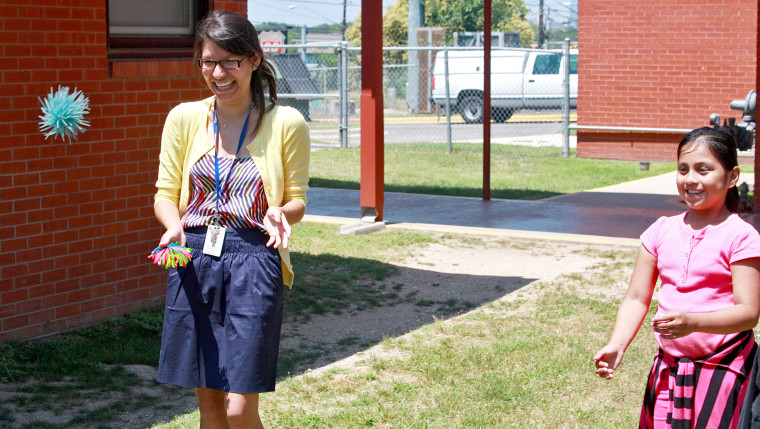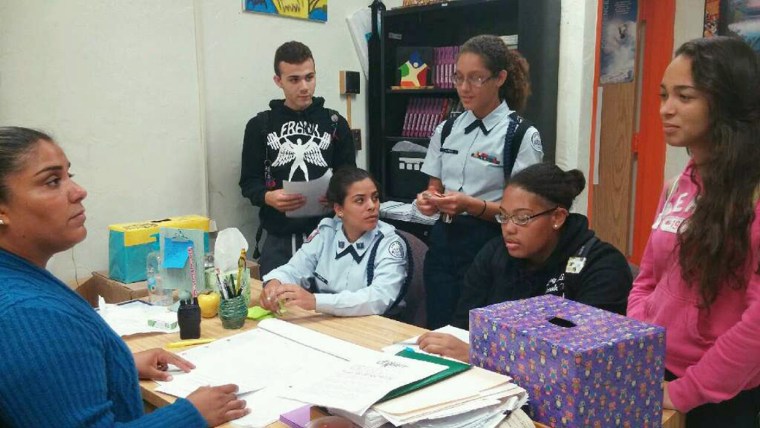Cruz Ramos proved her dedication to her job the day she faced down her fears of tarantulas and crawled underneath a home. But she is not a contractor or a builder. She is a site coordinator for Communities In Schools in South Texas, charged with overseeing students’ non-academic needs.
“I had some kids who were doing well in school, and then their grades started going down,” Ramos recalled. “Then they started having truancy problems. So I went to make a home visit to check in on them, and found out that their family had become homeless after their father abandoned them, and they were living in a condemned trailer.”
Ramos sprang into action to help the kids’ mother build a new home, doing everything from securing donations of wood from a nearby lumberyard to recruiting students from a technical school to help with wiring. At one point, she herself had to crawl underneath the trailer to remove some old wires. “Texas is known for tarantulas, and it was so dry and dark,” she said, “and I thought ‘Oh my God, what am I doing under a trailer?”
Ramos' fear that conditions might swallow her students' future was greater than her fear of tarantulas. By the time Ramos and her volunteers finished, her students had a new livable home, and the condemned trailer had been towed away.

Such efforts are at the core of Ramos’ work with Communities In Schools, the country’s largest dropout-prevention organization. Communities In Schools (CIS) is a nonprofit organization that focuses on providing social services to students, so that kids can succeed in school.
"We are removing the barriers that poverty imposes on students," says CIS president Daniel Cardinali. The organization's coordinators, many of them Latino, help children with everything from housing to eyeglasses to tutoring to ensure they stay in school.
CIS operates in 2,400 schools in 26 states, serving nearly 1.5 million young people and their families each year. It is funded through state and federal monies, corporate support, grants, and private donations.
According to their most recent report, in 2013-2014 Communities In Schools served a student population that was 44 percent Hispanic.
In the Communities In Schools model, site coordinators like Ramos are trained to identify students who are at risk of dropping out. They connect these students to community resources and help them meet their specific needs – whether it is school uniforms, glasses, tutoring, or a safe after-school meeting place. Then teachers can focus on their academic needs, and students can focus on learning.
Karina Chavarria, a CIS volunteer at Hamilton High School in Los Angeles, was present last summer when child migrants began showing up at her school. “Those kids had been through a lot,” she said. “They had the trauma of the migration process, and most of them didn’t know anyone here. Many of them also had significant gaps in their education.” Chavarria worked to help the students access therapy and counseling, but noted that “their level of fear was so high, they didn’t want to talk to anyone or do any paperwork.”

As part of her CIS work, Chavarria does workshops for immigrant parents, explaining the K-12 school pipeline (a system that is foreign to most of them), and the college application process. She notes that immigrant students may face other obstacles. “There is a significant indigenous population here in L.A. The parents may speak, say, Oaxacan, and can barely manage Spanish. Meanwhile the kids are becoming more assimilated and losing their Spanish, so the families don’t have a common language anymore.”
According to Communities In Schools data, their model of supporting students’ non-academic needs produces strong results. 99 percent of their students stay in school, 96 percent graduate, and 84 percent met their academic goals.
Nationally, the Pew Research Center reports that the U.S. high school dropout rate has reached a record low of 7 percent. The Hispanic dropout rate has fallen sharply, from 32 percent in 1993 to 14 percent in 2013. However, Latinos still had the highest dropout rate among all racial and ethnic groups.
Related: What's Behind the Falling Latino Dropout Rates?
"Our job is to accelerate the effectiveness of schools,” said Daniel Cardinali, the president of Communities in Schools. “We are in the business of freeing up teachers and principals to be their best, and to do what they were trained to do. We are removing the barriers that poverty imposes on students.” CIS coordinators and volunteers, he said, routinely deal with children who have issues including homelessness, food insecurity, high degrees of mobility, immigration status, and violence.
“Our public schools presume that students are being socialized by other environments in a way that mirrors how the schools are socializing them,” Cardinali said. “Schools presume that students are leading a middle-class home life. Yet reality can be far different. When a kid from a low-income background walks into school hungry, or with anger issues, he is not ready to conform, let alone to learn productively.”
Cardinali said that CIS looks for employees and volunteers who are capable of creating relationships with students. “It’s not enough to love a kid,” he said. “You have to be able to work with kids, to communicate with them, and help them remove their obstacles.”

The “community learning center” approach – similar to the CIS program – has lately been catching on around the country. Last November New York City Mayor Bill de Blasio announced a new program aimed at fixing the city’s most troubled schools, which included delivering social services on-site like CIS. Michigan Governor Rick Snyder is expanding a program that puts social workers from the state Department of Human Services into public schools.
Mariafe Arteaga, a CIS site coordinator in Homestead, Florida, believes forging strong relationships with her students is the key to their success. As part of her job, she has distributed backpacks and USBs to needy students, and even arranged with a local beauty school to provide free hair and makeup so a group of students could attend their prom. “These kids go through a lot, I admire them for being strong,” she said.

Arteaga tells of one student whose mother was murdered by her father, in foster care, and who later lost her grandmother. “Yet this child was always smiling, she never complained," Arteaga said. "She is the sole provider for herself and her grandfather, and she is an amazing human being!”
Arteaga believes that many kids act out because they don’t have an adult in their lives who will listen to them without judgment. So she keeps her office open to students, in order to encourage them to express their fears and frustrations. “This is a free zone, you can curse, you can come out of the closet, you can do anything!” she said. “I have 30 kids a day in my office. They come in, we talk, we laugh together, we cry together, they unload about all sorts of things. And then they are ready to go back to class.”
“Never in my wildest dreams did I think I would end up in a high school,” Arteaga said. “But what has taught me a lot, and helped me a lot is them (the students). Now I get the honor of seeing these children grow up every day. I have the best job in the world.”

